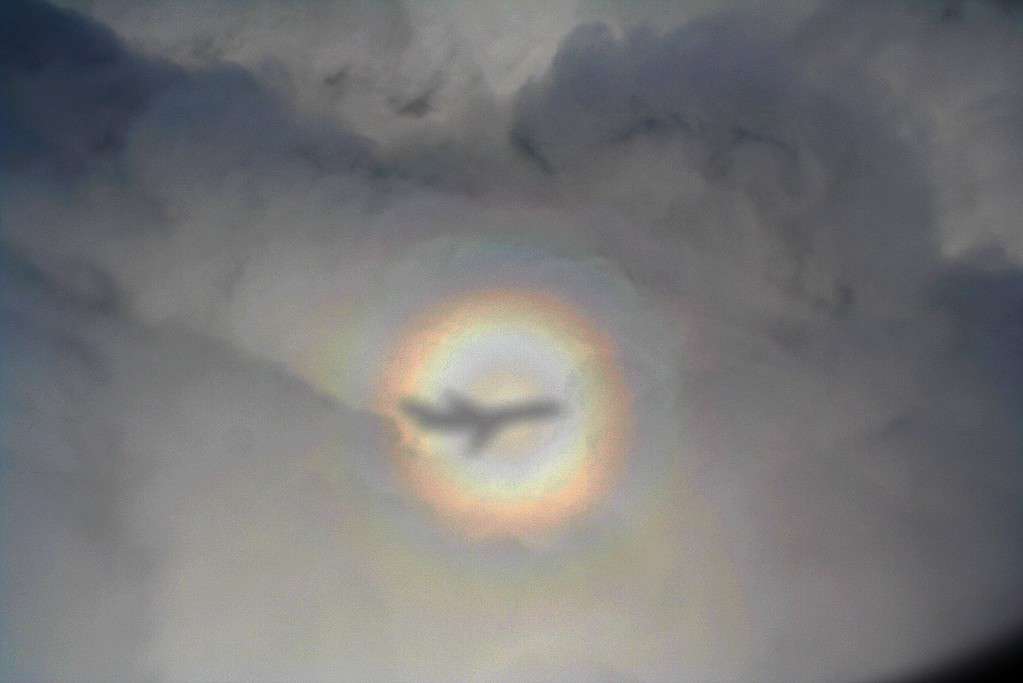Astronomers have made a pretty colorful discovery on WASP-76b, an ultra-hot giant exoplanet. This finding may reveal the first-ever observation of an extraterrestrial optical phenomenon known as a ‘glory.’ The phenomenon, akin to a circular rainbow, has been detected through atmospheric observations led by the CHEOPS (Characterising ExOplanet Satellite) space telescope.

Extrasolar glory
Glories are relatively widespread phenomena on Earth. They’ve also been detected on Venus. The effect arises when light is reflected by clouds composed of precisely uniform droplets. The droplets on Earth are formed of water, but the nature of those on WASP-76b is unknown. It could be iron, which has already been detected in the planet’s incredibly hot atmosphere.
A glory is a specific type of optical phenomenon that resembles a halo or a series of concentric, colorful rings. On Earth, glories are typically seen when an observer is situated between the Sun and a cloud of uniformly sized water droplets. This phenomenon occurs when light is scattered back towards where it came from, involving a mix of bending, bouncing, and splitting of light. To observe a glory requires very specific conditions. The observer must be in a direct line with the light source and the cloud, and the droplets within the cloud must be of nearly uniform size. But on a different planet with a different atmosphere, glories can look very differently.
“What’s important to keep in mind is the incredible scale of what we’re witnessing,” said Matthew Standing, an astronomer at the European Space Agency. “WASP-76b is several hundred light-years away — an intensely hot gas giant planet where it likely rains molten iron. Despite the chaos, it looks like we’ve detected the potential signs of a glory.”

The discovery on WASP-76b is the first of its sort beyond our solar system.
‘‘The reason why no such glory has ever been observed outside our solar system is that this phenomenon requires very specific conditions,” said Olivier Demangeon, an astronomer at the Instituto de Astrofísica e Ciências do Espaço in Portugal. “First of all, the atmospheric particles must be almost perfectly spherical, completely uniform and sufficiently stable to be observed throughout a long time. These droplets have to be directly illuminated by the planet’s host star, and the observer – in this case CHEOPS – must be in the right position.’’
WASP-76b’s Unique Atmosphere
WASP-76b orbits its host star at a distance much closer than the gap between Mercury and the Sun, exposing it to high levels of radiation. This close distance has a notable impact on its atmosphere. Its dayside temperature exceeds 4,352 degrees Fahrenheit (2,400 degrees Celsius), hot enough to melt metals. However, the nighttime temperature is substantially lower at a mere 2,400 degrees Fahrenheit (1,316 degrees Celsius). On the cooler night side, metal vapors condense into clouds. These clouds, possibly composed of iron droplets, set the stage for the potential formation of a glory.
The discovery emerged from a detailed analysis of data collected by CHEOPS, supplemented by observations from the TESS, Hubble, and Spitzer telescopes. Over a three-year period, researchers from multiple universities conducted twenty-three observations specifically looking at the planet’s secondary eclipses and phase curves. These observations unveiled an unexpected difference in brightness between the planet’s eastern and western edges. This brightness difference puzzled the astronomers, leading them to propose that a ‘glory’ might be responsible for the heightened brightness seen on the planet’s eastern side.
The proposed presence of a glory on WASP-76b is significant as it indicates unique atmospheric conditions and offers insights into cloud compositions on ultra-hot giants. Confirming the presence of a glory on WASP-76b would be a first for exoplanetary science.
“Never before have we seen these colorful, concentric rings on an extrasolar body,” said Thomas Wilson, University of Warwick astronomer. “So, this first exoplanetary glory, if confirmed with future studies, would make WASP-76b a truly unique body, and give us a beautiful tool for understanding the atmospheres of distant exoplanets and how habitable they could be.”
The work was published in Astronomy & Astrophysics.






